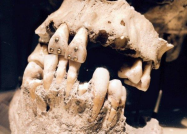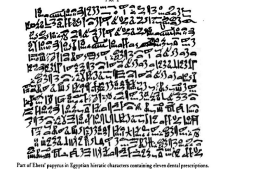August 14, 2025

By: AEOP Membership Council Ryan Joshi
What if the key to improving modern medicine lies in looking back at the past?
By studying the history of medicine and science, we can see how cultural, societal, and political contexts have shaped how we practice healthcare today. In turn, this can help us approach medicine in a more holistic, socially aware way, and build health systems that consider not just science, but the broader human experience.
My curiosity for the history of medicine was first ignited when my history teacher explained how the Egyptians used a powder made of crushed eggshells, pumice, and ashes to clean their teeth. While it was frankly disgusting to learn about, it also sparked my sense of intrigue. I wondered, “What other ways did societies back then address health issues and problems?” And so, my curiosity led me to delve into the fascinating history of dentistry and explore its strange and often surprising past.
 The ancient Egyptians are known as master builders, having constructed extravagant pyramids, but they were also pioneers in dental care. The world’s first dentist, Hesy-Re, was Egyptian! In ancient Egypt, rather than having breath mints, people chewed on aromatic twigs to freshen their breath. Additionally, to combat inflamed gums, there was a dental prescription that involved a mixture of cumin, frankincense, and carob. Some treatments even combined emmer seeds, ochre, and honey into a paste. Honey was commonly used because of its status as the ultimate antibacterial superhero of ancient times.
The ancient Egyptians are known as master builders, having constructed extravagant pyramids, but they were also pioneers in dental care. The world’s first dentist, Hesy-Re, was Egyptian! In ancient Egypt, rather than having breath mints, people chewed on aromatic twigs to freshen their breath. Additionally, to combat inflamed gums, there was a dental prescription that involved a mixture of cumin, frankincense, and carob. Some treatments even combined emmer seeds, ochre, and honey into a paste. Honey was commonly used because of its status as the ultimate antibacterial superhero of ancient times.
Willow bark used by the Egyptians had salicin, a precursor to aspirin. Papyri from that era show early forms of maxillofacial surgery, including descriptions of a fundamental functional assessment and treatments for jaw stabilization.
However, let’s not pretend that Egyptian dentistry was all that advanced. In fact, if you had a tooth infection, a priest might recite a prayer to help ward off the evil spirits causing your pain. Cavities were believed to be caused not by sugar but by supernatural forces. Moreover, bronze and copper tools were used to clean teeth, but they were not properly sterilized, leading to the spread of many infections. And remember anesthesia? Well, if you needed a tooth removed, the only way to do so was with a strong set of hands and some questionable tools. There was no way to ease the pain.
As children, many of us dreaded going to the dentist – the whir of the drill, the fear of having cavities, and the stern lectures we would get for not flossing all made it feel like a horror movie. But imagine how infinitely more terrifying dentistry was in ancient times – when toothpaste didn’t exist and anesthesia was unheard of. Today, we are far more more fortunate thanks to access to new technologies and advancements, unlike how it was back then.
 Learning about dental history has now become a passion of mine. Today, I am working on a six episode podcast series that explores the history of dentistry. Each episode will focus on a different era and civilization, examining how dental practices evolved and how they were shaped by cultural, social, and public health factors. The series will take listeners on a journey from ancient civilizations, where tooth extractions were primitive at best, to the sophisticated techniques we rely on today. We’ll explore how different cultures approached oral health — some with sacred reverence, while others viewed it as a societal taboo. After all, public health is deeply rooted in societal context.
Learning about dental history has now become a passion of mine. Today, I am working on a six episode podcast series that explores the history of dentistry. Each episode will focus on a different era and civilization, examining how dental practices evolved and how they were shaped by cultural, social, and public health factors. The series will take listeners on a journey from ancient civilizations, where tooth extractions were primitive at best, to the sophisticated techniques we rely on today. We’ll explore how different cultures approached oral health — some with sacred reverence, while others viewed it as a societal taboo. After all, public health is deeply rooted in societal context.
So, next time you’re sitting in the dentist’s chair, dreading the appointment, just remember — you’re not in ancient Egypt, chewing on twigs for fresh breath or relying on a prayer to fix your cavities. From Egypt’s natural remedies to modern advancements like anesthesia, we’ve come a long way. My podcast series will highlight the evolution of dentistry and its remarkable past.
Stay tuned for my podcast series!
Works Cited
Spielman, A. I. (2023). A timeline of the history of dentistry – history of dentistry and medicine: The illustrated encyclopedia of the History of Dentistry. History of Dentistry And Medicine | The Illustrated Encyclopedia of the History of Dentistry.
https://historyofdentistryandmedicine.com/a-timeline-of-the-history-of-dentistry/
Forshaw, R. The practice of dentistry in ancient Egypt. Br Dent J 206, 481–486 (2009). https://doi.org/10.1038/sj.bdj.2009.355
Mark, J. J. (2024, September 22). Ancient Egyptian agriculture. World History Encyclopedia. https://www.worldhistory.org/article/997/ancient-egyptian-agriculture/
Guerini, Dr. V. (1969). Dental Art Among The Egyptians. In A History Of Dentistry (pp. 19–31). essay, Milford H, National Dental Association of the United States of America.
Leipzig University, Germany. (2020). All about the Ebers Papyrus. Ebers papyrus: Universitätsbibliothek leipzig. https://www.ub.uni-leipzig.de/en/about-us/exhibitions/permanent exhibition/ebers-papyrus/
University Associates in Dentistry. “Hesy-Ra: History’S First Dentist.” University Associates in Dentistry, 30 Nov. 2016, www.uadchicago.com/uncategorized/hesy-ra-historys-first-dentist.
Find a Volunteering Opportunity
Visit our Program Volunteers page for a tool to find the best opportunity for you.
